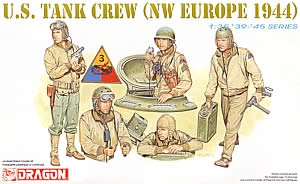| U.S.
Tank Crew (NW Europe 1944) |
 |
|
This set of five figures came out in 1996 and was well received by modelers who had tired of Tamiya's old chunky tank crew set and the three-figure crew included in the M4A3 Sherman. And compared to the price of a resin team, this set has been a bargain at $8.00. For the figure standing with the Colt .45 in his hand, you need to carefully removed the grip from the kit's pistol so it rests on the top of his hand. His trousers are the OD herringbone twill. He wears the canvas leggings usually associated with infantry, but these were standard issue for tankers as well. They just didn't like wearing them much if they didn't have to. Like three of the other tankers, he wears the winter combat jacket. This jacket was seen just about any time of year, and this figure and the driver are the two best suited (so to speak) for a summer Normandy setting. The other figures are more outfitted for colder weather. The commander looks to be on the horn with headquarters or another tank in his platoon, with a T-17 microphone that was used with several different Army radios; you'll need to clip off part of the hand to glue the upper portion the commander's hand. The M1 steel helmet is a reminder that the armored headgear offered no ballistic protection, being designed primarily to keep the crewman's head safe while jostling around inside the vehicle. He wears the winter combat trousers over his combat jacket and has a Colt inside the M7 holster strapped to his chest, and binoculars over the strap. It's not clear in the cover photo, but this is a full length figure. He'd look right at home in the turret of an M8 Greyhound as well as a Sherman or Chafee. The soldier carrying the jerry can looks like he's toting a full can of fuel. You need to remove the center grab bar on the can for his fist to slip into place. The M1 "grease gun" is very delicate, requiring care when removing the barrel and metal stock from the sprue (the barrel was broken in my set). He also wears the combat trousers, but under his jacket. The final two figures are serving from the waist up, one it his hands on the controls, the other leaning out the hatch. The latter tanker looks like a Soviet cosmonaut, but really he is sporting the winter combat helmet, which was more like a snapable toque, worn under the crash helmet. Construction of these figures is a little busier than one might expect. DML wanted to try to achieve the undercuts of the jacket lapels and head gear similar to what is found in the best resin figures, but the injection molding process of plastic kits makes this difficult, if not impossible. To compensate, the collars and lapels are separate pieces, as are the flaps on the four tanker helmets (only the flaps are seen peeking out from under the commander's steel pot). You also need to add your own wiring for the hand microphone and throat microphone and interphone box. Note that the tanker's crash helmet had an integral headset with a cord which connected to the cord leading from the communications devices. So even the two figures standing outside of the tank would still have a wire "tail" coming from behind the left or right side. This is an early DML set, and the sculpting is a little softer than recent kits, but still quite good for styrene. Sometimes DML figures have some "crazing" in the casting process, and my set is afflicted with this. It's most prominent on the backs of the torso pieces. I just look at it as an extra set of wrinkles for that lived-in look. This figures's faces do not look very lived-in, on the other hand, and like other DML faces, there is a sameness to all of them. So if they don't paint up as well as you'd like them to, you might swap them for Hornet or Warriors heads. As you may sense by now, this is a very versatile set of figures, and switching from the crash helmet heads to M1 helmets or bare heads gives you more opportunities with the three full length soldiers. This set regularly disappears, so if you prefer plastic figures over resin, you might want to put two or three sets aside on your shelf for a rainy day. -tss-
|
 |
 |
 |
 |
 |
 |
 |
 |
 |
 |
 |
 |
|
 Dragon
Models Limited
Dragon
Models Limited